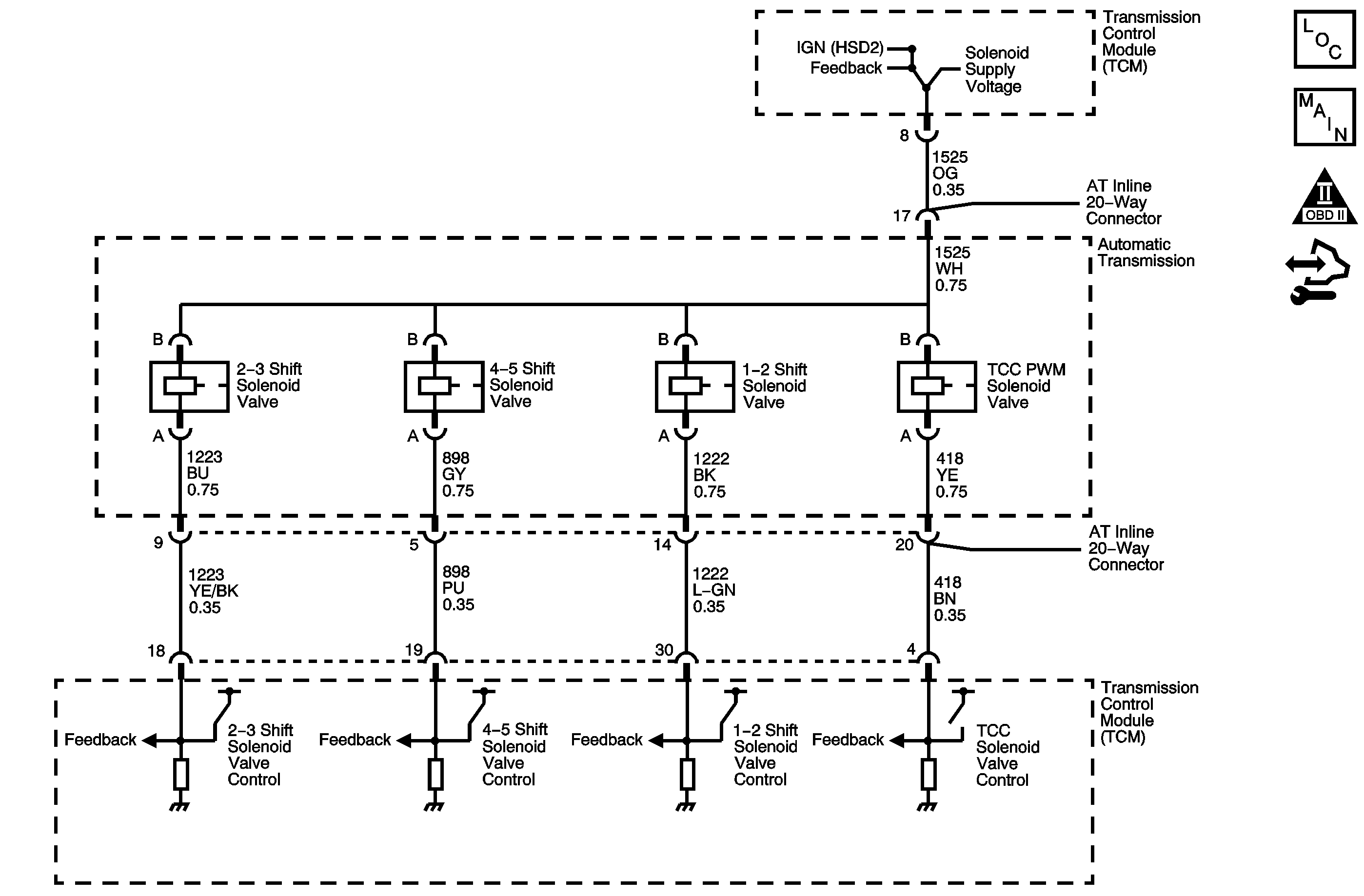
Circuit Description
The transmission control module (TCM) provides voltage to the pressure control solenoid, the shift solenoids, and the TCC PWM solenoid through two separate solid-state devices called High Side Drivers, called HSD1 and HSD2. HSD1 provides electrical power to the pressure control solenoid. HSD2 provides power to the shift solenoids. A normal function of the TCM is to run tests on each driver to ensure that it is functioning properly.
When the TCM detects a short to ground on HSD2, then DTC P1833 sets. DTC P1833 is a type B DTC.
DTC Descriptor
This diagnostic procedure supports the following DTC:
DTC P1833 Torque Converter Clutch (TCC)/Shift Solenoid (SS) Control Circuit Low Voltage
Conditions for Running the DTC
The engine run time is greater than 5 seconds.
Conditions for Setting the DTC
The TCM detects a short to ground on the HSD2 circuit when the HSD2 is commanded ON.
Action Taken When the DTC Sets
| • | The TCM requests the engine control module (ECM) to illuminate the malfunction indicator lamp (MIL) during the second consecutive drive trip in which the Conditions for Setting the DTC are met. |
| • | The TCM turns off power to all solenoids. |
| • | The transmission will operate in fifth gear if the vehicle has successfully completed a 1-2 upshift in the current ignition cycle. If the vehicle has not completed a 1-2 upshift in the current ignition cycle, the transmission will operate in fourth gear. |
| • | The TCM commands maximum line pressure. |
| • | The TCC is disabled. |
| • | The TCM freezes transmission adaptive functions. |
| • | At the time of the first failure, the TCM records the operating conditions when the Conditions for Setting the DTC are met. The TCM stores this information as a Failure Record. |
| • | At the time of the second failure, the ECM records the operating conditions when the Conditions for Setting the DTC are met. The ECM stores this information as a Freeze Frame. |
| • | The TCM stores DTC P1833 in TCM history. |
Conditions for Clearing the MIL/DTC
| • | The ECM turns OFF the MIL after the sixth consecutive drive trip in which the TCM does not send a MIL illumination request. |
| • | A scan tool can clear the MIL/DTC. |
| • | The TCM clears the DTC from TCM history if the vehicle completes 40 warm-up cycles without an emission related diagnostic fault occurring. |
| • | The TCM cancels the default actions when the ignition is OFF long enough in order to power down the TCM. |
Step | Action | Value(s) | Yes | No | ||||
|---|---|---|---|---|---|---|---|---|
1 | Did you perform the Diagnostic System Check - Vehicle? | -- | Go to Step 2 | Go to Diagnostic System Check - Vehicle in Vehicle DTC Information | ||||
2 |
Important:
Did DTC P1833 reset? | -- | Go to Step 3 | Go to Intermittent Conditions in Engine Controls - 2.8L or Intermittent Conditions in Engine Controls - 3.6L (LY7) | ||||
3 |
Did DTC P1833 reset? | -- | Go to Step 4 | Go to Step 5 | ||||
4 |
Did you find and correct the condition? | -- | Go to Step 9 | Go to Step 7 | ||||
5 | Test the solenoid supply voltage circuit between the AT inline 20-way connector and each individual solenoid for a short to ground. Refer to Testing for Short to Ground in Wiring Systems. Did you find a condition? | -- | Go to Step 8 | Go to Step 6 | ||||
6 | Replace the shorted solenoid. Refer to 1-2 Shift Solenoid Valve Replacement , 2-3 Shift Solenoid Valve Replacement , 4-5 Shift Solenoid Valve Replacement or Torque Converter Clutch Solenoid Replacement , as applicable. Is the action complete? | -- | Go to Step 9 | -- | ||||
7 | Replace the TCM. Refer to Control Module References in Computer/Integrating Systems for replacement, set-up and programming. Is the action complete? | -- | Go to Step 9 | -- | ||||
8 | Replace the internal transmission electrical harness. Refer to Transmission Internal Electrical Harness Replacement . Is the action complete? | -- | Go to Step 9 | -- | ||||
9 | Perform the following procedure in order to verify the repair:
Has the test run and passed? | -- | Go to Step 10 | Go to Step 2 | ||||
10 | With the scan tool, observe the stored information, capture info and DTC info. Does the scan tool display any DTCs that you have not diagnosed? | -- | Go to Diagnostic Trouble Code (DTC) List - Vehicle in Vehicle DTC Information | System OK |
